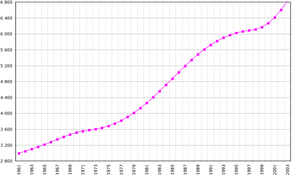Demographics of Burundi
2007 Schools Wikipedia Selection. Related subjects: African Geography
At 206.1 persons per km²., Burundi has the second-largest population density in Sub-Saharan Africa. Most people live on farms near areas of fertile volcanic soil. The population is made up of three major ethnic groups -- Bahutu (Hutu), Batutsi or Watusi (Tutsi), and Batwa (Twa). Kirundi is the common language. Intermarriage takes place frequently between the Hutus and Tutsis. The terms " pastoralist" and "agriculturist," often used as ethnic designations for Watusi and Bahutu, respectively, are only occupational titles which vary among individuals and groups. Although Hutus encompass the majority of the population, historically Tutsis have been politically and economically dominant.
Demographic data from the CIA World Factbook
Population
- 8,090,068
- Note: estimates for this country explicitly take into account the effects of excess mortality due to AIDS; this can result in lower life expectancy, higher infant mortality and death rates, lower population and growth rates, and changes in the distribution of population by age and sex than would otherwise be expected (July 2006 est.)
Age structure
- 0-14 years: 46.3% (male 1,884,825/female 1,863,200)
- 15-64 years: 51.1% (male 2,051,451/female 2,082,017)
- 65 years and over: 2.6% (male 83,432/female 125,143) (2006 est.)
- 15-64 years: 51.1% (male 2,051,451/female 2,082,017)
Population growth rate
- 3.7% (2006 est.)
Birth rate
- 42.22 births/1,000 population (2006 est.)
Death rate
- 13.46 deaths/1,000 population (2006 est.)
Net migration rate
- 8.22 migrant(s)/1,000 population (2006 est.)
Sex ratio
- At birth: 1.03 male(s)/female
- Under 15 years: 1.01 male(s)/female
- 15-64 years: 0.99 male(s)/female
- 65 years and over: 0.67 male(s)/female
- Total population: 0.99 male(s)/female (2006 est.)
- Under 15 years: 1.01 male(s)/female
Infant mortality rate
- Total: 63.13 deaths/1,000 live births
- Male: 70.26 deaths/1,000 live births
- Female: 55.79 deaths/1,000 live births (2006 est.)
- Male: 70.26 deaths/1,000 live births
Life expectancy at birth
- Total population: 50.81 years
- Male: 50.07 years
- Female: 51.58 years (2006 est.)
- Male: 50.07 years
Total fertility rate
- 6.55 children born/woman (2006 est.)
HIV/AIDS
- Adult prevalence rate: 6% (2003 est.)
- People living with HIV/AIDS: 250,000 (2003 est.)
- Deaths: 25,000 (2003 est.)
- People living with HIV/AIDS: 250,000 (2003 est.)
Major infectious diseases
- Degree of risk: very high
- Food or waterborne diseases: bacterial diarrhea, hepatitis A, and typhoid fever
- Vectorborne disease: malaria (2005)
- Food or waterborne diseases: bacterial diarrhea, hepatitis A, and typhoid fever
Nationality
- Noun: Burundian(s)
- Adjective: Burundian
Ethnic groups
- Hutu (Bantu) 85%, Tutsi (Hamitic) 14%, Twa (Pygmy) 1%, Europeans 7,000, South Asians 2,000
Religions
- Christian 67% (Roman Catholic 62%, Protestant 5%), indigenous beliefs 23%, Muslim 10%
Languages
- Kirundi (official), French (official), Swahili (along Lake Tanganyika and in the Bujumbura area)
Literacy
- Definition: age 15 and over can read and write
- Total population: 51.6%
- Male: 58.5%
- Female: 45.2% (2003 est.)
- Total population: 51.6%

